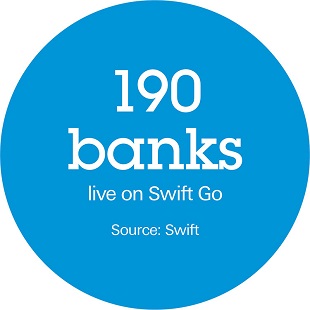17 August 2023
The launch of Swift Go in early 2021 was billed as another milestone for the cross-border payments space. A couple of years on, how has the story developed? flow investigates
MINUTES min read
In recent times, the cross-border payments industry has often been criticised for lack of transparency, speed and security, as well as high costs. Although that may be true for a very small percentage of cross-border payments (the vast majority are in fact straight-through processed within minutes), the industry is continuing with its transformation journey to overcome the remaining pain points and respond to changing client demands.
The first step in the transformation came with the introduction of Swift gpi in 20171, which provides end-to-end tracking for high-value cross-border payments. Today, Swift gpi has become the default standard for high-value cross-border transactions, and the industry has shifted its focus towards strengthening these strong foundations to further remove frictions.
This is where Swift Go comes in. Built upon the existing Swift gpi rails, the new service, focusing on lower-value payments (up to 10,000 in Euro, USD and GBP), enables consumers and SMEs to send fast, predictable, cost-effective and secure low-value payments. It also brings the potential for banks to reduce costs and drive revenues.
Opportunities remain
To identify where improvements could be made in low-value, cross-border payments, Swift surveyed 4,000 consumers and more than 2,000 SMEs across eight global markets: Australia, China, Germany, India, South Africa, Saudi Arabia, the UK and the US. It found that 85% of respondents consider their banks as the first port of call for international payments. Only 44% of consumers and SMEs reported actually preferring bank services for these payments, however, with other respondents preferring alternative solutions, such as fintechs and money transfer operators.2
“For those that do still prefer banks, the key drivers are the security and trust they offer”
“For those that do still prefer banks, the key drivers are the security and trust they offer, whereas those that prefer alternative offerings cite the ease, speed and competitive pricing they provide as the main draw,” says Fabien Depasse, Global Product Lead, Swift Go & Pre-validation, Swift. “It’s really about the overall user experience: having predictability from the start, knowing exactly how much it is going to cost and when the payment will arrive.”
A way forward was mapped out in the results for the traditional banking community: 83% of SMEs and 76% of consumers agreed that they would be likely to consider banks if they were able to provide the same level of service and experience as fintech offerings.3
“There is volume to be regained here. There are new volumes to develop, and there are new opportunities for additional payment volumes in the consumer and SME space,” explains Depasse. “It’s driven by our ability as an industry to deliver on the ease the speed and the competitive prices and match that user experience.”
The story so far
Swift Go builds on the foundational success of Swift gpi, which, over the past six years, has made significant headway in improving high-value cross-border payments in terms of speed, transparency and tracking capabilities.
By comparison, Swift Go provides banks with a similar service for the low-value cross-border payment space, and is designed to enable faster, more predictable and competitively priced low-value cross-border payments for small businesses and consumers.
“Swift Go has its parameters that should make it cheaper for us as banks to process”
“We wanted to ensure that Swift Go could build on existing investments, while also simplifying processes,” says Marc Recker, Global Head of Product – Institutional Cash Management, Deutsche Bank. “I see Swift Go as a kind of an economy class of payments. Swift Go has its parameters that should make it cheaper for us as banks to process, but with the same level of trust.”
Swift Go is designed to provide a seamless service offering for both banks and clients, and can help improve low-value payments in three main ways:
- An enhanced customer offering:
This can be delivered through full predictability of payment conditions (time, fees, amount) and by the full payment value being delivered to end customers through Swift Go banks. This in turn will result in improved payment processing, which can even be performed instantly where available. - Increased harmonisation:
The single format requirement will foster standardisation. A common currency guide is provided for Swift Go banks. - Cost reduction:
This common currency guide, along with stricter network validation will drive higher straight-through-processing (STP) rates between correspondents, reducing costs. There is also a roadmap to achieve full STP.
From strength to strength

The service launched at the start of 2021 with 12 signed-up banks that were headquartered across nine countries. Subsequent growth has gone from strength to strength, with over 660 banks signed up today across 139 countries, and 190 banks now live.4
This strong adoption curve shows that the challenge of bank disintermediation is recognised everywhere and that banks around the world believe the responsible and viable response should be through industry-wide collaboration.
“We see the exact same pattern as we have seen with Swift gpi in the past, with banks signing up one year and going live the next year. So, we are expecting this number of live banks to grow quite significantly this year, as we are onboarding all those who signed up in 2022,” says Depasse. “The momentum is there – the banking industry really wants to react to those new entrants, and not to give away those volumes, but to claim them back and to offer that customer experience that is helping the fintechs steal this away.”
Deutsche Bank – one of the Swift Go pioneers – is already live as a euro intermediary and is working as an instructed bank as well, with US dollar and GBP planned towards H2 2023. The bank is also working internally and with Swift to offer its financial institution clients yet to be onboarded to the service the full business benefits: for example, by making the tracker available on client portals.
An ongoing evolution
Getting the right model behind Swift Go has proved to be an iterative process for Swift and its banking partners. The initial model for Swift Go payments relied heavily on inter-bank charges, and take-up did not materialise as hoped.
At the end of 2022, Swift and the Swift Go banks met in London to discuss progress. The talks revealed that for the 620 signed-up banks to be fully onboarded under the current rules, every single bank would need a new bilateral agreement and a new claim process with each intermediary in order for the system to be viable. Not only would this not be scalable, but it also became clear that the cost of the inter-bank charges under the current model was not leading to competitive prices.

“This precipitated a shift in mindset,” explains Recker. “We knew the process was inefficient, and so if we simply recreate the status quo between banks under the umbrella of Swift Go, that does not help us. Something needed to change”.
In response, the product has undergone an evolution, with participants unanimously agreeing to adapt the current model as follows to remove the main hurdles to adoption:
- All Swift Go banks adhere to the no deduct rule to ensure full principal amount credit to beneficiary
- Beneficiary banks can charge their customers a separate fee
- Swift Go Banks do not claim on each other, dramatically reducing the effort in bilaterally agreeing prices for Go payments
- Swift Go intermediary banks can charge a processing fee to their Go ordering or Go beneficiary bank customers (as per existing market practices and commercial agreements between banks)
How it works
Picture the scene: a debtor in Australia wants to transfer €100 to an end beneficiary in Europe. The instructing agent – an Australia-based bank that is a member of Swift Go – will send funds to the currency intermediary – in this case, Deutsche Bank. For its role in enabling euro flows for the Australian bank, Deutsche Bank will have a fixed transaction fee in place for this relationship, paid via a monthly invoice. In this example, the indicative transaction fee is 1.2, meaning that if the instructing agent sent 1,000 payments per month it would pay Deutsche Bank €1,200 (1,000 x 1.2).
The instructed agent, based in Europe, will then credit the end beneficiary. Previously, in this same flow, the instructed agent would have been able to make a claim against Deutsche Bank. Importantly, this means the €100 stays the same across the value chain, with not a single euro cent deduction taking place.
A way forward
If banks can no longer take fees from other banks in the chain, will they lose all their revenues? The Swift Go model addresses this possibility.
“From a bank perspective, we should not be afraid of Swift Go costing us all of our revenues, as we do not need to put all of our payments through the rails. Instead, we will all need to think about it intelligently and strategically within our own organisations,” says Recker. “We could, for example, create a new product for clients that leverages Swift Go in the background, as the enabler for the solution. There are plenty of options for banks – it is just about working towards and using the right one.”
The primary focus for now, however, remains on building adoption – as the widespread support of the Swift Go service will be the key to its success.
Sources
1 See "SWIFT gpi: a progress report" at flow.db.com
2 See swift.com
3 See swift.com
4 See swift.com



